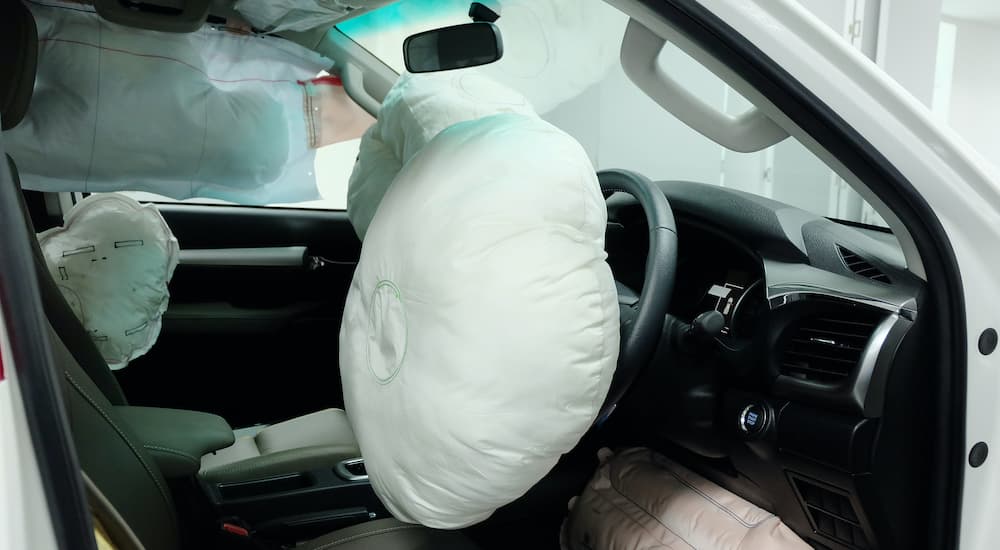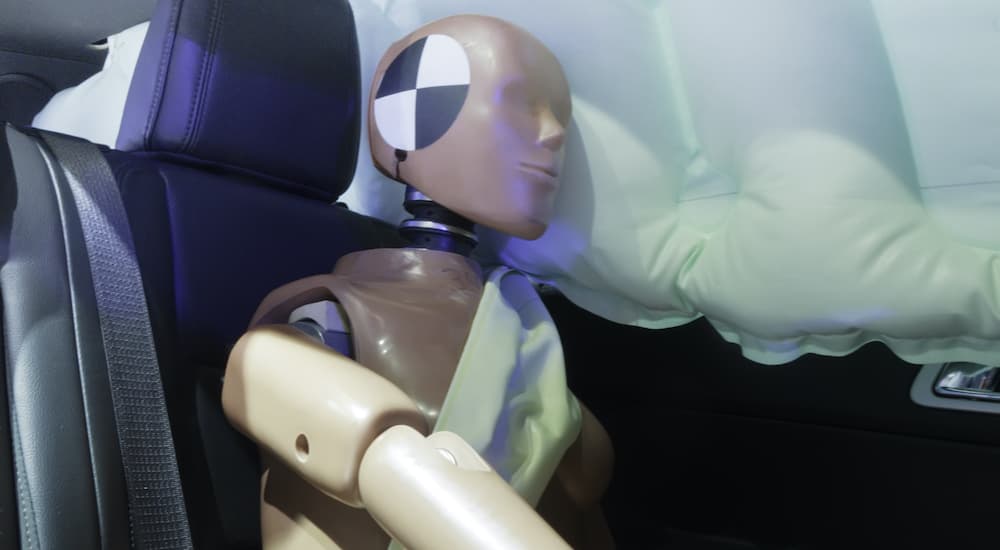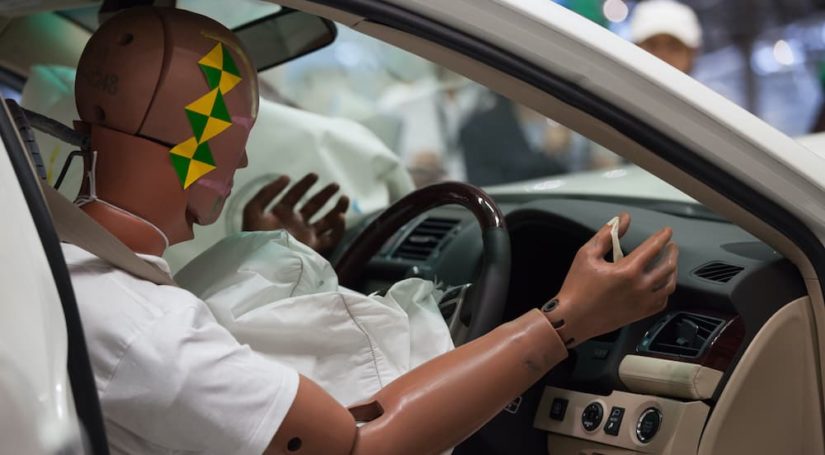The single most-important thing when looking at any vehicle, whether you’re researching to buy tomorrow or in a couple of years, is how well it can keep you safe. In a perfect world, everyone would abide by speed limits, drive safely and cautiously, and always remain focused on the road around them. Of course, that’s not what happens, and the real world is filled with drivers going far too fast, distracted by things inside and outside of their vehicle, or just downright daydreaming while flying down the highway at speeds the human brain can’t really process.
In another decade or two, self-driving cars could eliminate collisions completely and create safe roads for everyone. Until then, however, we’re stuck with being surrounded by others on the road that could easily plow into us at a moment’s notice. Safe, defensive driving helps, of course, but safety features on vehicles also make a huge difference. To help with this, groups like the Insurance Institute for Highway Safety (IIHS) conduct safety tests to determine which vehicles can best protect their occupants in the event of a collision.
Side-Impact Testing
The IIHS conducts a number of different tests to see how well various vehicles can manage in a wide range of different types of impacts. One of the most important ones that they conduct is a side-impact test, which simulates what happens when one vehicle slams into another from the side. While head-on crashes might be the most violent and devastating, side-impact collisions are incredibly deadly: 23% of occupant deaths in passenger vehicles in 2018 were due to side impacts, according to the IIHS’s data.
To try to combat this, the IIHS has run side-impact tests for years in order to showcase which vehicles offer the most protection. Not only does this help you choose a model that will help keep you safe, but it encourages manufacturers to push for better safety standards. A lot of shoppers trust the results of these kinds of tests and keep them in mind when looking for their next vehicle. So if you’re a car manufacturer, you want to rank highly in terms of safety in order to help boost your sales.
Best of all, it actually works. When the IIHS first started conducting side-impact collision tests in 2003, only about 20% of the vehicles they tested received a good rating; today, 99% of vehicles earn a good rating. A study of 10 years’ worth of crash data that was conducted in 2011 found that a driver in a vehicle with a “good” safety rating was 70% less likely to die in a left-side collision (a side-impact that hits the driver’s side) than someone driving a vehicle with a “poor” safety rating. More good-rated vehicles mean fewer deaths.

New Side-Impact Testing Standards
These results are great, but it also means that manufacturers can become complacent and stop improving upon what they’ve made. After all, even with these improved ratings from 18 years ago, more than 20% of vehicle deaths are coming from side-impact crashes. To try to help with this, the IIHS recently decided to change their side-impact testing in order to make them more challenging – and to ensure they more accurately reflect real-world conditions that occur in this type of collision.
In order to devise this new testing standard, the IIHS looked at side-impact crashes in the real world and determined that they were more severe than their current testing conditions. The current standards use a vehicle with a large, moveable barrier on the front-end that weighs 3,300 lbs, and the impact occurs with the striking vehicle moving at 31 mph. To better emulate real-world impacts, the IIHS made the barrier on the front of the vehicle larger, with a different design that more closely acts like the front-end of a large SUV or pickup truck. They increased the weight of this barrier to 4,180 lbs and the striking vehicle will now collide with the test vehicle at a speed of 37 mph.
This might not sound like that much of a difference, but remember that one of the most basic elements of physics is that force is equal to mass times acceleration (F=MA). By increasing both the weight of the barrier (the mass) and the speed of the striking vehicle (the acceleration), the force of the impact is greatly increased. Just the boost from 31 mph to 37 mph increased the impact energy by 42% – both changes resulted in 82% more energy in the impact than the previous testing standards. Has this changed the results?
The Results of the New Testing
Yes, yes, it has – dramatically. Remember when I said that with the current standards, 99% of vehicles receive a “good” rating in the testing? With these new standards, only a single small SUV out of 20 that were tested earned a “good” from the IIHS. It’s important to note that this was a test run, so to speak, as this new side-impact testing won’t become their official standard for their ratings until 2023. To get a sense of what the results will look like, they tested the following 2021 models of small SUVs and got these results:
- Mazda CX-5: Good
- Audi Q3: Acceptable
- Buick Encore: Acceptable
- Chevy Trax: Acceptable
- Honda CR-V: Acceptable
- Nissan Rogue: Acceptable
- Subaru Forester: Acceptable
- Toyota RAV4: Acceptable
- Toyota Venza: Acceptable
- Volvo XC40: Acceptable
- Chevy Equinox: Marginal
- Ford Escape: Marginal
- GMC Terrain: Marginal
- Hyundai Tucson: Marginal
- Jeep Compass: Marginal
- Jeep Renegade: Marginal
- Kia Sportage: Marginal
- Lincoln Corsair: Marginal
- Honda HR-V: Poor
- Mitsubishi Eclipse Cross: Poor
As you can see, only the Mazda CX-5 received a good overall rating, while nine other models received an acceptable rating, which is decent but certainly not what the IIHS is hoping for in the future. A further eight models received a marginal rating, which means there’s a lot of room for improvement, and two earned a poor rating. Of particular note is the Honda HR-V, which not only received a poor rating but was exceptionally bad at taking a hit from the side.
During the testing on the HR-V, the B-pillar, which is the part of the vehicle between the front and rear doors, actually tore away from the structure of the vehicle. In a side impact, the B-pillar takes a lot of force, so how well it can handle that energy is very important. The Honda HR-V showed the worst results in this regard, and this resulted in the barrier on the front of the impact vehicle intruding almost halfway into the cabin of the test Honda. If someone had been sitting there driving, with a passenger behind them, then both of them would suffer serious injuries from such a collision – a potentially fatal one.

What This Means for the Future
As I said before, this testing is not going to reflect on the official IIHS ratings for these vehicles this year because this was an early test to see how these updated standards are going to impact the future results. So if you look at the ratings for these 2021 models, or even 2022 models, they’ll all reflect how well they did on the older version of these tests. That being said, they still showcase some interesting trends and useful information.
Clearly, the Mazda CX-5 is well-designed for taking the abuse of a side impact, even more so than pretty much every other small SUV out there. When combined with the acceptable results, then half of the vehicles tested were able to pass – you can decide on whether this particular glass is half-full or half-empty. However you choose to read it, if trends continue from the past, then manufacturers are going to be quick to use these results and change the way they build their cars, trucks, and SUVs to better handle side impacts. This means we’ll have safer vehicles in the years to come, which is always a good thing.

